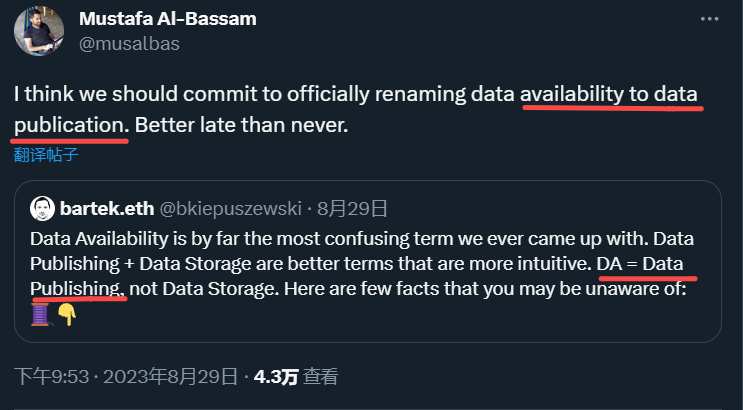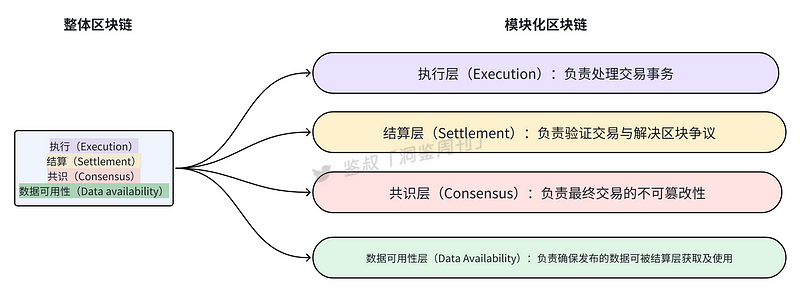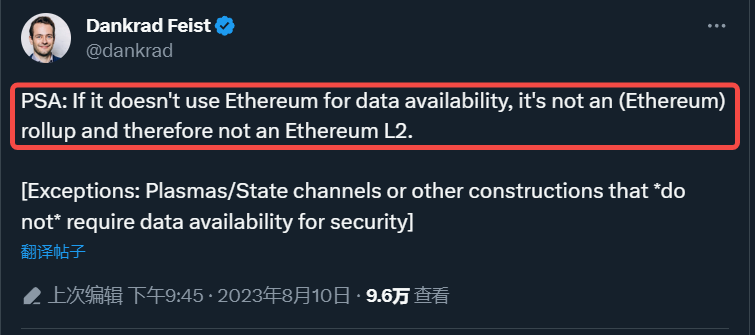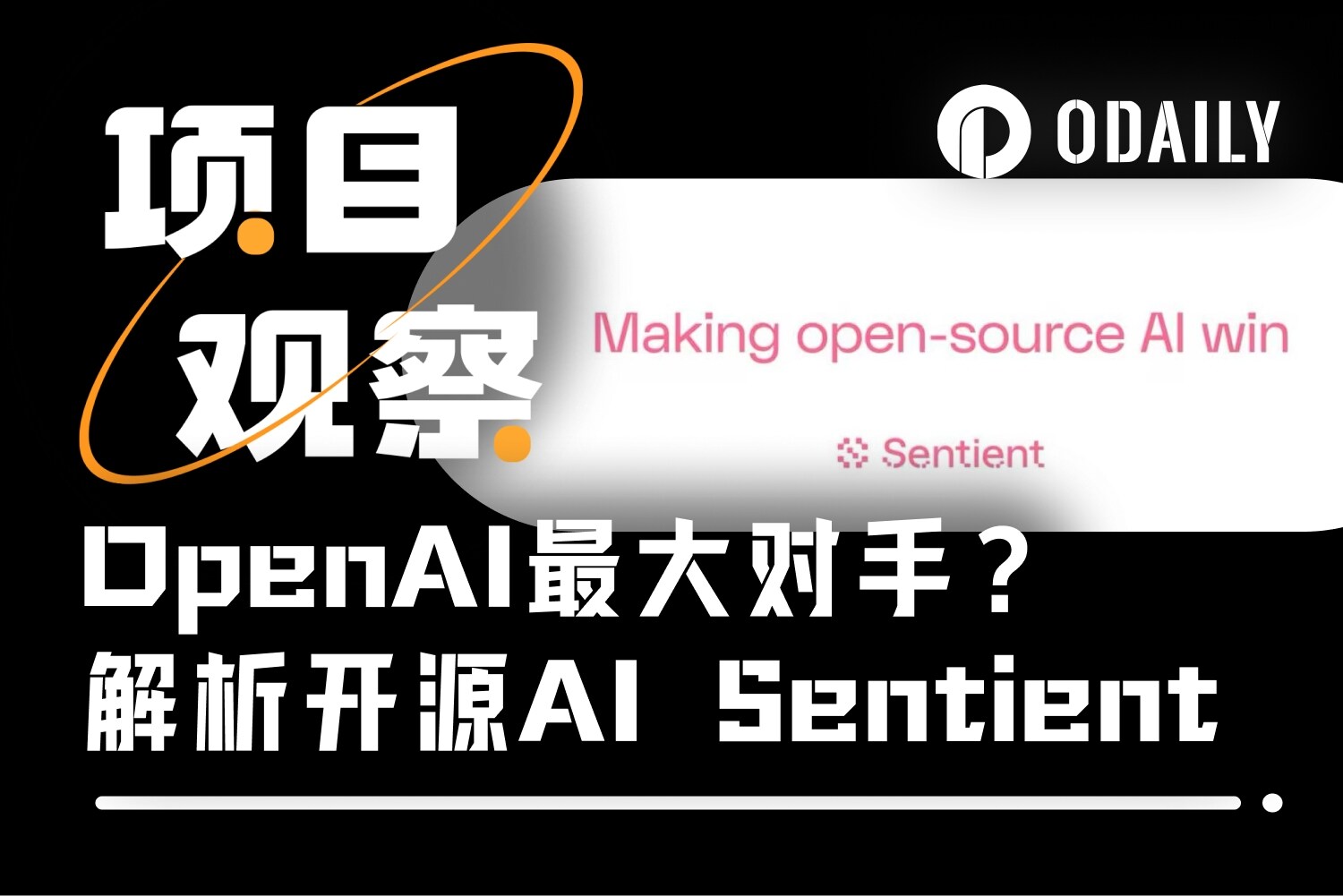Why is data availability so important for Layer 2?
Ethereum Foundation researcher Dankrad Feist once said in a tweet that it would not be L2 without using Ethereum for data availability. If he goes by what he said, then many chains will be kicked out of L2 teams, such as Arbitrum Nova, Polygon and Mantle.
So, what exactly is data availability? What data availability issues does L2 face? Why is there so much controversy about data availability layer L2? This article will focus on these issues and try to uncover the mystery of data availability.
What is data availability?
Simply put, data availability means that the block producer publishes all the transaction data of the block to the network so that validators can download it.
If a block producer publishes the complete data and makes it available for validators to download, we say the data is available; if it withholds some data so that validators cannot download the complete data, we say the data is unavailable.
The difference between data availability and data retrieval
Often, we tend to confuse data availability with data retrieval, but they are actually very different.
Data availability involves the stage when a block is produced but has not yet been added to the blockchain through consensus. Therefore, data availability is not related to historical data, but to whether newly released data can pass consensus.
Data retrieval involves the stage after the data has passed consensus and is stored forever on the blockchain, that is, the ability to retrieve historical data. The nodes that store all historical data in Ethereum are called archive nodes.
Therefore, the co-founder of L2 BEAT once stated in a long tweet that the full nodes are not obliged to provide us with historical data. The reason why we can get it is just because the full nodes are kind enough.

At the same time, he also said that the term data availability (Data Availability) will cause people to misunderstand its role, and it should be replaced by data publishing (Data Publishing). This statement was also agreed by the founder of Celestia.

Data availability issues in L2
Although the concept of data availability comes from Ethereum, we are currently focusing on data availability at the L2 level.
In L2, the sequencer is the block producer. They must publish enough transaction data so that the verifier can check whether the transaction is valid. (If you want to know more about Sequencer, please read the previous articles of Dongjian Weekly Research Report|Principles, Current Situation and Future of Sequencer》)
However, there are two problems faced in this process. One is to ensure the security of the verification mechanism, and the other is to reduce the cost of publishing data. This will be introduced in detail below.
Issues ensuring that authentication mechanisms are conducted securely
We know that OP Rollup uses fraud proof to verify the validity of transactions, while ZK Rollup uses validity proof.
For OP Rollup: If the sequencer does not publish complete data that can retrace the block, the challenger in the fraud proof will not be able to initiate a valid challenge;
For ZK Rollup: Although the validity proof itself does not require data availability, ZK Rollup as a whole still requires data availability. If there is no data that can retrace the block, then the user will not be able to know his balance and is likely to lose his assets.
In order to ensure safe verification, current L2 sequencers generally publish L2 status data and transaction data on the highly secure Ethereum, relying on Ethereum for settlement and data availability.
Therefore, the data availability layer is actually where L2 publishes transaction data. Currently, mainstream L2 uses Ethereum as the data availability layer.
Reduce the cost of publishing data
Todays L2 simply takes data availability and settlement on Ethereum. Although it has sufficient security, it also bears huge costs. This is also the second problem faced by L2, which is how to reduce the cost of publishing data.
The total Gas paid by users to L2 is mainly composed of the Gas incurred by L2 executing transactions and the Gas incurred by L2 submitting data to L1. The former fee is minimal, while the latter is the bulk of user fees. Among them, transaction data released to ensure data availability accounts for L2 submits the main part of the data to L1, and the proof data to verify that the transaction is valid only accounts for a small part.

Therefore, if you want to make L2 cheaper overall, you must reduce the cost of publishing data. So, how to reduce costs? There are two main methods:
Reduce the cost of publishing data on L1, such as the upcoming EIP-4844 upgrade of Ethereum. Friends who are interested in the EIP-4844 upgrade can read the previous article of Dongjian Weekly Web3 Popular Science | Easily understand the benefits of Layer 2: EIP-4844》;
Following the example of Rollup, which separates transaction execution from L1, data availability can also be separated from L1 to reduce costs, that is, Ethereum is not used as the data availability layer.
L2 Controversy over Data Availability Layer
To talk about L2’s controversy over the data availability layer, we have to start with the modular blockchain. Modular blockchain decouples the core functions of the overall blockchain to form relatively independent parts, and expands the performance of a single blockchain through the combination of various dedicated networks.
Although there is still some controversy over the layering of modular blockchains, it is currently generally accepted that modular blockchains are divided into four layers, namely execution layer (Execution), settlement layer (Settlement), and consensus layer (Consensus). and data availability layer (Data Availability). The functions of each module are as follows:

Modular blockchain is similar to Lego bricks. It can be customized and use the best building blocks to build a good model, which alleviates the impossible triangle problem of blockchain.
However, in addition to separating the execution layer from Ethereum, the current L2 functions of the other three layers are still performed on Ethereum. However, due to cost considerations, many L2s are also preparing to separate the data availability layer from Ethereum and use Ethereum only as the settlement layer and consensus layer.
Interestingly, Ethereum does not seem to want L2 to obtain data availability from elsewhere. Ethereum Foundation researcher Dankrad Feist once said in a tweet that it is not Rollup without using Ethereum as the data availability layer, and therefore it is not L2.

At the same time, L2 BEAT’s latest definition of L2 also points out that expansion solutions that do not publish data on L1 are not L2, because using off-chain data availability solutions cannot guarantee that operators will provide the published data.

Of course, there is no final conclusion on what L2 is. The above members of the Ethereum Foundation and L2 BEAT insist that L2 should keep the data availability layer in Ethereum. It seems to be for security reasons, but is there any actual right? What about the worries about Ethereum’s status being shaken?
Ethereums vision is to become a supercomputer platform. Later, in order to improve network performance, it had to develop Rollup and many ecology developed on the cheaper L2. However, because the security is provided by Ethereum, it does not affect Ethereums status. Not much impact. But if L2 also divests the data availability layer involved in data release from Ethereum, it will essentially weaken its reliance on Ethereums security and gradually move away from Ethereum, which will pose a threat to Ethereums status.
However, no matter what, it still cannot stop the vigorous development of projects related to the data availability layer. In the next article about data availability, the author will introduce in detail the main data availability solutions currently on the market and specific related projects, so stay tuned.



